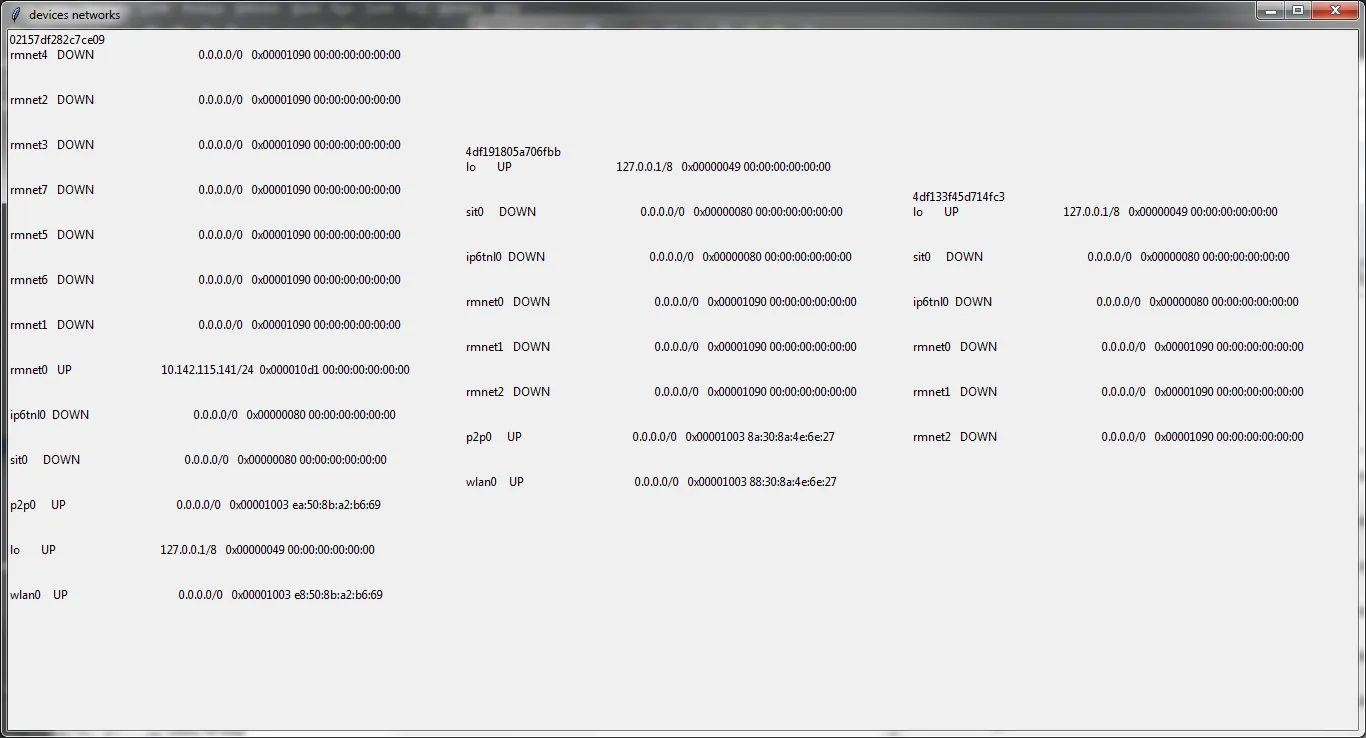我已经搜索了几个小时,但还是找不到答案。请帮帮我。
我想在Android中使用VpnService来获取网络数据包,就像应用程序tPacketCapture一样。
我开始使用谷歌的ToyVpn示例代码,并对其进行修改,以便我不将数据发送到服务器。然而,我不确定这是否正确。
我的配置方法在调用establish()之前使用wlan IP地址来进行binder.addAddress()。我正在使用Nexus 7,并使用“adb shell netcfg | grep wlan0”获取地址:
wlan0 UP 192.168.0.6/24 0x00001043 10:bf:48:bf:5f:9d
然后将其添加到我的方法中:
private void configure() throws Exception {
// If the old interface has exactly the same parameters, use it!
if (mInterface != null) {
Log.i(TAG, "Using the previous interface");
return;
}
// Configure a builder while parsing the parameters.
Builder builder = new Builder();
builder.setMtu(1500);
builder.addAddress("192.168.0.6", 24);
try {
mInterface.close();
} catch (Exception e) {
// ignore
}
mInterface = builder.establish();
}
调用此方法后,我调用修改后的run方法,将一个字符串作为参数传递,这并不重要,因为我没有在任何地方使用它。
private void run(String run) throws Exception {
configure();
FileInputStream in = new FileInputStream(mInterface.getFileDescriptor());
// Allocate the buffer for a single packet.
ByteBuffer packet = ByteBuffer.allocate(32767);
// We use a timer to determine the status of the tunnel. It
// works on both sides. A positive value means sending, and
// any other means receiving. We start with receiving.
int timer = 0;
// We keep forwarding packets till something goes wrong.
while (true) {
// Assume that we did not make any progress in this iteration.
boolean idle = true;
// Read the outgoing packet from the input stream.
int length = in.read(packet.array());
if (length > 0) {
Log.i(TAG,"************new packet");
while (packet.hasRemaining()) {
Log.i(TAG,""+packet.get());
//System.out.print((char) packet.get());
}
// Write the outgoing packet to the tunnel.
packet.limit(length);
// tunnel.write(packet);
packet.clear();
// There might be more outgoing packets.
idle = false;
// If we were receiving, switch to sending.
if (timer < 1) {
timer = 1;
}
}
}
}
当我执行adb logcat时,什么也没有发生。我这样做对吗?我觉得我漏掉了什么。
谢谢!
编辑:
从日志中,我看到以下行:
I/ActivityManager( 460): START u0 {act=android.intent.action.MAIN cat=[android.intent.category.LAUNCHER] flg=0x10000000 cmp=com.example.android.toyvpn/.ToyVpnClient} from pid 10247
I/ActivityManager( 460): Start proc com.example.android.toyvpn for activity com.example.android.toyvpn/.ToyVpnClient: pid=10287 uid=10122 gids={50122, 3003, 1028}
I/ActivityManager( 460): Displayed com.example.android.toyvpn/.ToyVpnClient: +1s144ms
I/Vpn ( 460): Switched from [Legacy VPN] to com.example.android.toyvpn
D/Vpn ( 460): setting state=IDLE, reason=prepare
I/ToyVpnService(10287): running vpnService
D/Vpn ( 460): setting state=CONNECTING, reason=establish
D/VpnJni ( 460): Address added on tun0: 192.168.0.6/24
I/Vpn ( 460): Established by com.example.android.toyvpn.ToyVpnService on tun0
W/ContextImpl( 460): Calling a method in the system process without a qualified user: android.app.ContextImpl.bindService:1406 com.android.server.connectivity.Vpn.establish:289 com.android.server.ConnectivityService.establishVpn:3263 android.net.IConnectivityManager$Stub.onTransact:504 android.os.Binder.execTransact:351
D/Vpn ( 460): setting state=AUTHENTICATING, reason=establish
所以看起来正在连接。
完整源代码:
public class ToyVpnService extends VpnService implements Handler.Callback, Runnable {
private static final String TAG = "ToyVpnService";
private Handler mHandler;
private Thread mThread;
private ParcelFileDescriptor mInterface;
@Override
public int onStartCommand(Intent intent, int flags, int startId) {
// The handler is only used to show messages.
if (mHandler == null) {
mHandler = new Handler(this);
}
// Stop the previous session by interrupting the thread.
if (mThread != null) {
mThread.interrupt();
}
// Start a new session by creating a new thread.
mThread = new Thread(this, "ToyVpnThread");
mThread.start();
return START_STICKY;
}
@Override
public void onDestroy() {
if (mThread != null) {
mThread.interrupt();
}
}
@Override
public boolean handleMessage(Message message) {
if (message != null) {
Toast.makeText(this, message.what, Toast.LENGTH_SHORT).show();
}
return true;
}
@Override
public synchronized void run() {
Log.i(TAG,"running vpnService");
try {
runVpnConnection();
} catch (Exception e) {
e.printStackTrace();
//Log.e(TAG, "Got " + e.toString());
} finally {
try {
mInterface.close();
} catch (Exception e) {
// ignore
}
mInterface = null;
mHandler.sendEmptyMessage(R.string.disconnected);
Log.i(TAG, "Exiting");
}
}
private boolean runVpnConnection() throws Exception {
configure();
FileInputStream in = new FileInputStream(mInterface.getFileDescriptor());
// Allocate the buffer for a single packet.
ByteBuffer packet = ByteBuffer.allocate(32767);
// We keep forwarding packets till something goes wrong.
while (true) {
// Assume that we did not make any progress in this iteration.
boolean idle = true;
// Read the outgoing packet from the input stream.
int length = in.read(packet.array());
if (length > 0) {
Log.i(TAG,"************new packet");
System.exit(-1);
while (packet.hasRemaining()) {
Log.i(TAG,""+packet.get());
//System.out.print((char) packet.get());
}
packet.limit(length);
// tunnel.write(packet);
packet.clear();
// There might be more outgoing packets.
idle = false;
}
Thread.sleep(50);
}
}
public String getLocalIpAddress()
{
try {
for (Enumeration<NetworkInterface> en = NetworkInterface.getNetworkInterfaces(); en.hasMoreElements();) {
NetworkInterface intf = en.nextElement();
for (Enumeration<InetAddress> enumIpAddr = intf.getInetAddresses(); enumIpAddr.hasMoreElements();) {
InetAddress inetAddress = enumIpAddr.nextElement();
Log.i(TAG,"****** INET ADDRESS ******");
Log.i(TAG,"address: "+inetAddress.getHostAddress());
Log.i(TAG,"hostname: "+inetAddress.getHostName());
Log.i(TAG,"address.toString(): "+inetAddress.getHostAddress().toString());
if (!inetAddress.isLoopbackAddress()) {
//IPAddresses.setText(inetAddress.getHostAddress().toString());
Log.i(TAG,"IS NOT LOOPBACK ADDRESS: "+inetAddress.getHostAddress().toString());
return inetAddress.getHostAddress().toString();
} else{
Log.i(TAG,"It is a loopback address");
}
}
}
} catch (SocketException ex) {
String LOG_TAG = null;
Log.e(LOG_TAG, ex.toString());
}
return null;
}
private void configure() throws Exception {
// If the old interface has exactly the same parameters, use it!
if (mInterface != null) {
Log.i(TAG, "Using the previous interface");
return;
}
// Configure a builder while parsing the parameters.
Builder builder = new Builder();
builder.setMtu(1500);
builder.addAddress("192.168.0.6", 24);
try {
mInterface.close();
} catch (Exception e) {
// ignore
}
mInterface = builder.establish();
}
}
